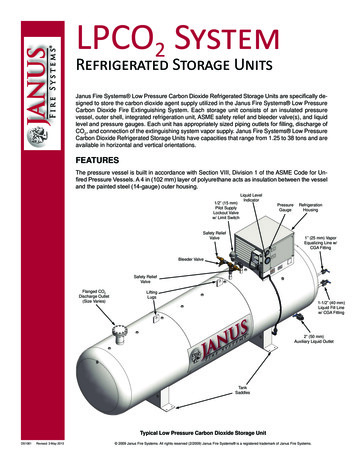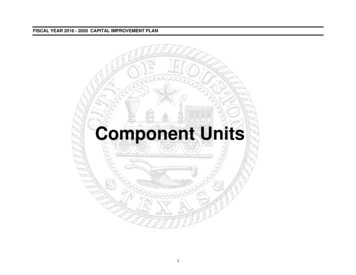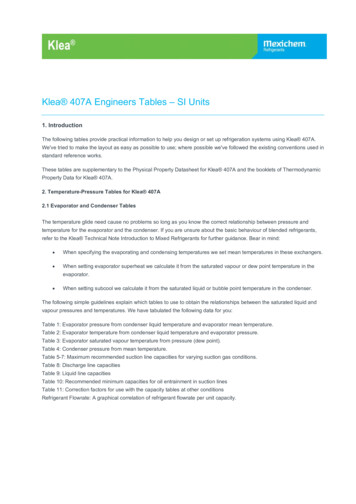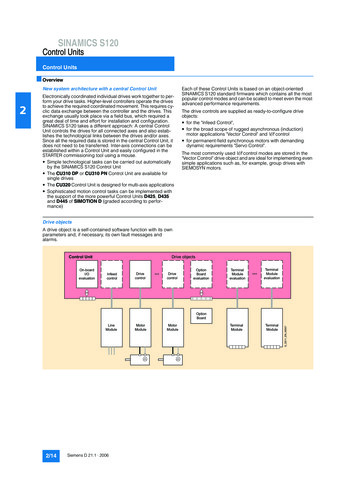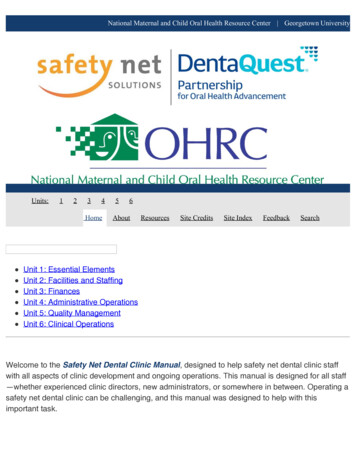
Transcription
National Maternal and Child Oral Health Resource Center Georgetown UniversityUnits:1234Home56AboutResourcesSite CreditsSite IndexFeedbackSearchUnit 1: Essential ElementsUnit 2: Facilities and StaffingUnit 3: FinancesUnit 4: Administrative OperationsUnit 5: Quality ManagementUnit 6: Clinical OperationsWelcome to the Safety Net Dental Clinic Manual, designed to help safety net dental clinic staffwith all aspects of clinic development and ongoing operations. This manual is designed for all staff—whether experienced clinic directors, new administrators, or somewhere in between. Operating asafety net dental clinic can be challenging, and this manual was designed to help with thisimportant task.
The manual was developed by a team of experts. Funding for the second edition of the manualwas provided by the DentaQuest Partnership for Oral Health Advancement and by the U.S.Department of Health and Human Services, Health Resources and Services Administration,Maternal and Child Health Bureau under cooperative agreement (U44MC30806) to GeorgetownUniversity, National Maternal and Child Oral Health Resource Center.This material includes general guidelines. The laws of each state may vary, and the reader maywant to contemplate seeking legal advice from an attorney licensed in the state the health careprovider practices for specific guidance.
National Maternal and Child Oral Health Resource Center Georgetown UniversitySafety Net Dental Clinic ManualUnits:1234Home56AboutResourcesSite CreditsSite IndexFeedbackSearchHomeAboutResourcesSite CreditsSite IndexSearchAboutThis is a manual designed for you—no matter whether you’re an experienced clinic director, a newadministrator, or somewhere in between. We know how challenging running a safety net dentalclinic is, and that’s where the manual comes in—to help you with just about everything related toclinic development and operations.The manual is divided into six units:Unit 1: Essential ElementsUnit 2: Facilities and StaffingUnit 3: FinancesUnit 4: Administrative OperationsUnit 5: Quality ManagementUnit 6: Clinical Operations
How will you use this manual?How will you use this manual?Experienced clinic director? New clinic administrator? Either way, you've come to the right place.You may view the units as a series of steps to follow when launching a dental clinic or focus onparticular topics of interest. The manual includes a wealth of resources on topics to make your lifeeasier: tools like supply lists, floor plans, photographs, budget worksheets, quality-improvementplans, fact sheets, and websites and other resources on topics like clinic policies, clinic efficiency,professional standards, funding strategies, and clinic design.Who needs this manual?Who needs this manual?Perhaps you are a safety net dental clinic director facing major challenges. Your clinic has a longwaiting list and has been mired in red ink for years. You want to make the clinic efficient andsustainable. You don't know whether the solution lies in improved staffing patterns, revised clinicpolicies, or facility design. Or is the problem that you lack a business plan? This manual discussesthe pros and cons of various options and links to other resources to help you make decisions.What is the dental care safety net?What is the dental care safety net?The dental care safety net is where people goWhen they don't have a regular dentistBecause they know their Medicaid card will be acceptedBecause they won't be turned away when they are in pain and can't afford careBecause the clinic is close to home and linked to their other health care providersThe Institute of Medicine's report, America's Health Care Safety Net (2000), defines safety netproviders as those who "organize and deliver a significant level of health care and other healthrelated services to uninsured, Medicaid, and other vulnerable patients." Safety net clinics may beoperated by federally qualified health centers, local health departments, neighborhood healthcenters that are private not-for-profit agencies, rural health centers, Indian Health Service or tribalunits, institutions, schools, hospitals, or other entities.Why do we need a dental care safety net?Why do we need a dental care safety net?The Surgeon General's Report, Oral Health in America (2000), provides a thorough review of thenation's oral health and the need for both community-based and individual approaches to
prevention and treatment of oral conditions. It also emphasizes that oral health is essential togeneral health and that systemic conditions influence oral health. Despite advances in technologyand the scientific understanding of oral diseases, significant disparities exist in oral disease ratesand access to dental care among subgroups of the population. The dental safety net attempts tobridge the gap for these disenfranchised groups.DentaQuest Partnership for Oral Health Advancement’s Safety Net Solutions and the NationalMaternal and Child Oral Health Resource Center have created this revised edition, in collaborationwith a team of experts. The original manual was produced by the Ohio Department of Health’sBureau of Oral Health Services in collaboration with the Association of State and Territorial DentalDirectors and Indian Health Services. We gratefully acknowledge the expertise and effort of allcollaborators over the span of the manual's lifetime.Safety Net Dental Clinic ManualNational Maternal and Child Oral Health Resource CenterGeorgetown UniversityThis material includes general guidelines. The laws of each statemay vary, and the reader may want to contemplate seeking legaladvice from an attorney licensed in the state the health careprovider practices for specific guidance.
National Maternal and Child Oral Health Resource Center Georgetown UniversitySafety Net Dental Clinic ManualUnits:1234Home56AboutResourcesSite CreditsSite IndexFeedbackHomeAboutResourcesSite CreditsSite IndexSearchResourcesOrganizationsAssociation of State and Territorial Dental DirectorsMobile-Portable Dental ManualCenters for Disease Control and PreventionOral HealthDentaQuest Partnership for Oral Health Advancement, Safety Net SolutionsOnline Learning CenterSearch
Indian Health ServiceOral Health Program GuideNational Network for Oral Health AccessDental Program ManagementNational Maternal and Child Oral Health Resource CenterBright Futures: Oral Health—Pocket GuideOral Health Care During Pregnancy: A National Consensus StatementConsumer Materials in English and Other LanguagesSpecial Care: An Oral Health Professional’s Guide to Serving Young Children with SpecialHealth Care NeedsAll publicationsTopical ResourcesTopicsCommunity Water FluoridationCommunity Water FluoridationFluoride in WaterDental SealantsEvidence-based Clinical Practice Guidelines for the Use of Pit-and-Fissure SealantsRecommendationsDental Caries: School-based Dental Sealant Delivery ProgramsSchool-Based Dental Sealant ProgramsDisease Management and Risk AssessmentDentaQuest Disease Management SeriesADA Caries Risk Assessment and ManagementDentaQuest Special Topics SeriesAAPD Caries Risk Assessment and Management for Infants, Children, and AdolescentsFluoride SupplementsFluoride Supplement Dosage Schedule
Non-Fluoride Containing AgentsNon-Fluoride Caries Preventing AgentsPractice ManagementHenry Schein Dental, Inc. 2015. The Patient-Centered Dental-Health Home: An EssentialGuide for Planning the CHC Dental Facility ExpansionNational Network for Oral Health Access. 2009–. Operations manual for health center oralhealth programs. Denver, CO: National Network for Oral Health Access.Topical FluoridesProfessionally-Applied and Prescription-Strength, Home-Use Topical Fluoride Agents forCaries Prevention Clinical Practice GuidelineTransmission of DiseaseCenters for Disease Control and Prevention. 2003. Guidelines for infection control in dentalhealth-care settings—2003. MMWR Recommendations and Reports 52(RR-17):1–61.Centers for Disease Control and Prevention, Division of Oral Health. 2016. Recommendationsfrom the Guidelines for Infection Control in Dental Health-Care Settings, 2003. Atlanta, GA:Centers for Disease Control and Prevention.Centers for Disease Control and Prevention, Division of Oral Health. 2016. InfectionPrevention Checklist for Dental Settings: Basic Expectations for Safe Care (also in Spanish).Atlanta, GA: Centers for Disease Control and Prevention.Centers for Disease Control and Prevention, Division of Oral Health. 2016. Summary ofInfection Prevention Practices in Dental Settings: Basic Expectations for Safe Care (also inSpanish). Atlanta, GA: Centers for Disease Control and Prevention.Cleveland JL, Gray SK, Harte JA, Robison VA, Moorman AC, Gooch BF. 2016. Transmissionof blood-borne pathogens in US dental health care settings: 2016 Update. Journal of theAmerican Dental Association 147(9):729-738.Cleveland JL, Foster M, Barker L, Brown GG, Lenfestey N, Lux L, Corley TJ, Bonito AJ. 2012.Advancing infection control in dental settings. Journal of the American Dental Association143(10):1127–1138.Klevens RM, Moorman AC. 2013. Hepatitis C virus: An overview for dental health careproviders. Journal of the American Dental Association 144(12):1340–1347.Oklahoma State Department of Health and Tulsa Health Department. 2015. DentalHealthcare-Associated Transmission of Hepatitis C: Final Report of Public Health
Investigation and Response, 2013.Redd JT, Baumbach J, Kohn W, Nianan O, Khristova M, Williams I. 2007. Patient-to-patienttransmission of hepatitis B virus associated with oral surgery. Journal of Infectious Diseases195(9):1311–1314.Radcliffe RA, Bixler D, Moorman A, Hogan VA, Greenfield VS, Gaviria DM, Patel PR,Schaefer MK, Collins AS, Khudyakov YE, Drobeniuc J, Gooch BF, Cleveland JL. 2013.Hepatitis B virus transmissions associated with a portable dental clinic, West Virginia, 2009.Journal of the American Dental Association 144(10):1110–1118.Safety Net Dental Clinic ManualNational Maternal and Child Oral Health Resource CenterGeorgetown UniversityThis material includes general guidelines. The laws of each statemay vary, and the reader may want to contemplate seeking legaladvice from an attorney licensed in the state the health careprovider practices for specific guidance.
National Maternal and Child Oral Health Resource Center Georgetown UniversitySafety Net Dental Clinic ManualUnits:1234Home56AboutResourcesSite CreditsSite IndexFeedbackSearchHomeAboutResourcesSite CreditsSite IndexSearchSiteCreditsSafety Net Dental Clinic Manual (2nd ed.)Cite asDoherty M, Bingham D, Kislak R, Kolo S, Barzel R, Holt K (eds.). 2018. Safety Net Dental ClinicManual (2nd ed.). Westborough, MA: DentaQuest Partnership for Oral Health Advancement;Washington, DC: National Maternal and Child Oral Health Resource Center.
Senior EditorsMark Doherty, D.M.D., M.P.H., C.C.H.P., Safety Net SolutionsKatrina Holt, M.P.H., M.S., R.D., FAND, National Maternal and Child Oral Health Resource CenterEditorsRuth Barzel, M.A.Dori Bingham, B.A.Sarah KoloEditor and Project CoordinatorRebecca Kislak, J.D.Associate EditorDanielle Apostolon, B.S.Essential ElementsUnit EditorSteve Geiermann, D.D.S.Contributing Subject Matter ExpertMarty Lieberman, D.D.S.Facilities and StaffingUnit EditorWilliam Donigan, D.D.S., M.P.H.Contributing Subject Matter ExpertsJack Luomanen, D.M.D.Bruce Wilcox, D.M.D.FinancesUnit EditorAllen Patterson, C.P.A., C.G.M.A., F.A.C.M.P.E., M.H.A.Contributing Subject Matter Experts
Greg LaChance, D.D.S.Maggie Maule, D.M.D., M.B.A.Administrative OperationsUnit EditorBob Russell, D.D.S., M.P.H.Contributing Subject Matter ExpertsCarolyn Brown, D.D.S.Jane Gillette, D.D.S.Tim Martinez, D.M.D.David Rosenstein, D.M.D., M.P.H.Bruce Wilcox, D.M.D.Scott Wolpin, D.M.D.Quality ManagementUnit EditorMark Koday, D.D.S.Clinical OperationsUnit EditorBob Russell, D.D.S., M.P.H.Contributing Subject Matter ExpertsSung-Kiang Chuang, D.M.D., M.D., D.M.Sc.Kathy Eklund, R.D.H., M.H.P.Jane Gillette, D.D.S.Tim Martinez, D.M.D.ReviewersSteve Geiermann. D.D.S.Beverly Isman, R.D.H., M.P.H.Special ThanksSpecial thanks to Mark Doherty and Dori Bingham of the DentaQuest Partnership for Oral HealthAdvancement’s Safety Net Solutions and Katrina Holt of the National Maternal and Child Oral
Health Resource Center for their commitment to producing the manual.FundingFunding for the second edition of the manual was provided by the DentaQuest Partnership for OralHealth Advancement and the Health Resources and Services Administration (HRSA) of the U.S.Department of Health and Human Services (HHS) under award #U44MC30806 for the NationalMaternal and Child Center for Oral Health Systems Integration and Improvement in the amount of 4,000,000 over 4 years with no funding from nongovernmental sources. This information orcontent and conclusions are those of the authors and should not be construed as the official policyof HRSA, HHS, or the U.S. government, nor should any endorsements be inferred.CopyrightSafety Net Dental Clinic Manual (2nd ed.) 2018 by National Maternal and Child Oral HealthResource Center, Georgetown UniversityPermission is given to save and print this publication and to forward it, in its entirety, to others.Requests for permission to use all or part of the information contained in this publication in otherways should be sent to the address below.All materials produced by other organizations that are included in this manual are being used withthe permission of the author or publisher.National Maternal and Child Oral Health Resource CenterGeorgetown UniversityBox 571272Washington, DC 20057-1272(202) 784-9771E-mail: OHRCinfo@georgetown.eduWebsite: www.mchoralhealth.orgFirst EditionEditorBeverly Isman, R.D.H., M.P.H.Mark Siegal, D.D.S., M.P.H.
AuthorsJay Balzer, D.M.D., M.P.H.Beverly Isman, R.D.H., M.P.H.R. Frank Martin, D.D.S., M.P.H.John Neale, D.D.S., M.P.H.Cathy Raymond, R.D.H., B.S.Mark Siegal, D.D.S., M.P.H.HistoryAlthough many have recognized the value of a comprehensive safety net dental clinic manual, itwas the vision of the Ohio Department of Health’s Bureau of Oral Health Services that brought itinto being. The original manual (2003) was an ambitious undertaking that required a partnershipamong agencies and individuals. The manual was a collaboration between the Ohio Department ofHealth, the Indian Health Service, and the Association of State and Territorial Dental Directors.Mark Siegal served as project director and Beverly Isman was primary editor and project manager.FundingThe development of the manual was supported by HRSA, MCHB, through Ohio’s Title V Maternaland Child Health Services Block Grant (grant number: B04MC0031206) and Community IntegratedServices Systems Grants (grant numbers: H47MC0001103 and H47MC0001104) as well asthrough a cooperative agreement with the Association of State and Territorial Dental Directors(contract number: U93MC0017703). Special thanks to John Rossetti, MCHB, for providing valuableassistance to the project.Safety Net Dental Clinic ManualNational Maternal and Child Oral Health Resource CenterGeorgetown UniversityThis material includes general guidelines. The laws of each statemay vary, and the reader may want to contemplate seeking legaladvice from an attorney licensed in the state the health care
National Maternal and Child Oral Health Resource Center Georgetown UniversitySafety Net Dental Clinic ManualUnits:1234Home56AboutResourcesSite CreditsSite IndexFeedbackSearchHomeAboutResourcesSite CreditsSite IndexSearchSite IndexUse the site index below to locate specific topics in the manual, or visit the search page. Acomplete download of this site is available as a PDF file. The site may have updates that are morecurrent than the PDF download, which is generated quarterly.Unit 1: Essential ElementsUnit 1: Essential ElementsSection 1: Partnerships and PlanningTelling Your StoryCommunity Oral Health Needs AssessmentGathering the FactsBuilding Collaborative Relationships
Defining Potential PartnersEngaging PartnersClinic PlanningLevel of ServiceOrganizing for ActionSection 2: Key PrinciplesCharacteristics of an Efficient and Effective Dental ProgramKey Practice Parameters for SustainabilityTracking Productivity and PerformanceDetermining Dental Clinic CapacityStrategic PlanningBest PracticesUnit 2: Facilities and StaffingUnit 2: Facilities and StaffingSection 1. Facility Design and ConstructionCapacity and Cost EstimatesLocation, Size, and Floor Space ConsiderationsLocationSizeFloor SpaceDesign PrinciplesDesign Options and Floor PlansOpen or Enclosed OperatoriesOperatory LayoutCompliance Requirements for Facility DesignConstruction OptionsErgonomic DesignSection 2. Equipment and SuppliesDelivery SystemsOver-the-Patient DeliveryRear DeliverySide DeliveryMajor EquipmentPatient ChairsDental Units
Dental HandpiecesOperator and Assistant StoolsX-Ray UnitsConventional vs. Dental X-RaysDental Operating LightsComputersCommunications SystemsPre-Owned EquipmentElectronic Dental SystemsChallengesWhat Can Be IntegratedImplications for Facility DesignKey Features of Electronic Dental SystemsWireless TechnologySupplies and Small EquipmentMaintenance and RepairGeneral MaintenancePreventive MaintenanceEquipment RepairService LifeSection 3. StaffingStaffing ConfigurationsStaffing DecisionsDental AssistantsDental Hygienists in Alternative PracticeExpanded Function Dental AuxiliariesUnit 3: FinancesUnit 3: FinancesSection 1. Financial ViabilityBalancing Access and SustainabilityInteractive Budget-Planning WorkbookRevenuePatient Care RevenuePublic Programs
Commercial InsuranceSelf-Pay PatientsEstimating Patient-Care RevenueNumber of Patient Visits or EncountersAverage Reimbursement per Visit or EncounterFactors That Affect Patient-Care RevenueDetermining Appropriate Clinic FeesRelative Value UnitsDeveloping a Relative Value Units Conversion FactorSliding Fee ScheduleImplement a Sliding Fee ScheduleContractsOther Sources of RevenueExpensesCompensation PackagesTypical Fringe BenefitsVolunteersDental Equipment and Supply CostsOther ExpensesBad DebtEquipment DepreciationLab FeesAdministrative ExpensesFundraisingSection 2. Clinic FinancesManaging Clinic FinancesAssistance with Financial ManagementDeveloping a BudgetFinancial Reporting for Program Planning and ManagementAssessing Financial Performance and SustainabilityBusiness PlansBusiness Plan Success FactorsSafety Net Dental Clinic Business Plan ModelIndependent AuditsSection 3. Grants and FundraisingGrants
GrantwritingGrants ManagementSources of GrantsGovernment FundingFoundation FundingCorporate FundingFundraisingUnit 4: Administrative OperationsUnit 4: Administrative OperationsSection 1: Policies and ProceduresPolicies and Procedures ManualFormat and TopicsEvidence-Based Clinical Care GuidelinesTime-Out PolicyOral Surgical Procedures PolicySection 2: Human ResourcesEmployee HandbookProfessional Standards of ConductPosition DescriptionsSalaried Employees, Contractors, And VolunteersRecruitingInterviewingCredentialing and PrivilegingSample Dental Provider Privileging ProceduresCredentialing and Privileging DetailsAdditional ConsiderationsNational Practitioner Data BankOrientationRetentionTraining and Continuing Dental EducationDisciplining or Terminating EmployeesSection 3: Liability ProtectionMalpractice Insurance
Risk ManagementCommon Risk Management IssuesIncident ReportsRequired InsuranceFederal Tort Claims Act (FTCA)Section 4: SchedulingAppointment SystemStrategies for Scheduling AppointmentsScheduling in AdvanceBroken AppointmentsPreventing Broken AppointmentsCompensating for Broken AppointmentsEmergency AppointmentsConsiderations for Dental Emergency PatientsWrongful Termination or AbandonmentRecall/Re-care AppointmentsContinuum of CareTips for Managing ReferralsPatient Rights and ResponsibilitiesInformed ConsentWithdrawal of ConsentInformed Consent Policies and ProceduresConsent for MinorsMinors Under Age 14Adolescents Age 14-18Informed RefusalWritten Follow-Up InstructionsInterpretation ServicesSection 5: Billing and CollectionsEstablishing a Billing and Collections SystemElectronic Dental RecordSuperbills, Charge Slips, And Encounter FormsResponsibilities for Billing and Collections ProcessSection 6: Inventory ManagementPurchasing and Stocking Supplies
Tracking and Managing InventoryDental SuppliersStocking a FormularyUnit 5: Quality ManagementUnit 5: Quality ManagementSection 1. The Vision for QualityHealth Care QualityQuality AssuranceQuality ImprovementQuality Improvement ProcessQuality ControlAdopting an ApproachDeveloping Your Quality VisionQuality Vision StatementPrioritizing the Quality VisionHealth Resources and Services Administration Requirements for Federally Qualified HealthCentersOral Health Quality Improvement Committee vs. Health Center Quality ImprovementCommitteeStandards of Care and GuidelinesSection 2. Setting the Stage for n 3. Measuring to Improve QualityApplying Quality Assurance/Quality Improvement Principles in the Dental ClinicClinic AdministrationPatient RegistrationBilling and CollectionsPurchasing/Inventory ManagementReferrals and the Continuum of CareAppointment System, Including Broken AppointmentsIncident Reporting. Processing Patient Complaints, Treatment Issues, and Safety EventsAccess and Its Effect on Quality
Retention of StaffComplianceOnboarding of StaffElectronic Dental Record and Chart NotesConsentPatient-Satisfaction SurveysStaff-Satisfaction SurveysClinical ServicesMethods of Measuring Clinical QualityQuality MetricsQuality-Based ReimbursementIncident-Driven Peer ReviewInitiating Peer ReviewPeer Review Through Existing Components of Local Dental SocietiesPeer Review Within the Dental OfficeThe Review ProcessClinical Quality ControlCuring-Light IntensityEmergency Kit Expiration DatesEmergency Oxygen CanistersPost-Operative CallsPreventive MaintenanceX-Ray DeveloperMonitor LogsActing on FindingsSection 4. Data Collection and AnalysisCollecting DataAnalyzing DataFlow ChartCause-and-Effect DiagramPareto DiagramScatter DiagramHistogramRun ChartControl ChartSharing Results of Quality-Assurance/Quality-Improvement ActivitiesDeveloping a Patient-Satisfaction Survey
Administering Patient-Satisfaction SurveysAnalyzing Patient-Satisfaction SurveysUnit 6: Clinical OperationsUnit 6: Clinical OperationsSection 1: Health RecordsHealth RecordElectronic Templates and Clinic FormsInactivationElements of the Health RecordGuidelines for Records MaintenanceConfidentialityHealth Insurance Portability and Accountability ActSection 2: Infection Control, Environmental Health, and SafetyInfection Control and RegulationOrganizations That Support Infection Control and SafetyCenters for Disease Control and PreventionOccupational Safety and Health AdministrationDental Evaluation and Consultation ServiceOrganization for Safety, Asepsis and PreventionAmerican Dental AssocationBloodborne Pathogens and Needlestick PreventionPost-Exposure ManagementProducts and Devices for Infection Prevention and ControlWaterline MaintenanceMonitoring and Evaluating ComplianceRegulation of Hazardous MaterialsMercuryRadiationNitrous OxideMedical EmergenciesLife Safety CodeWork-Related Accident DocumentationEmergency PreparednessClinic Security
Other Clinic Safety IssuesEye ProtectionEmergency Treatment of Eye InjuriesNoise ControlVentilationSection 3: Clinical TopicsClinical and Prevention IssuesTreating Medically Complex PatientsClinical and Community-Based Prevention StrategiesClinical Diagnosis and Clinical TechniqueTreating Patients with Special Health Care NeedsBehavior ManagementConscious SedationSection 4: Dental Office TechnologyInformation and Clinical TechnologyInformation Systems and Information ManagementComputer Hardware and Software SelectionTechnology IntegrationDigital RadiographyOther Technical EquipmentDIAGNOdentIntraoral CameraAir AbrasionDental LasersApex Locators and Rotary EndodonticsCAD/CAM Milling System3D PrintersDentaQuest Partnership for Oral Health Advancement’s Safety Net Solutions and the NationalMaternal and Child Oral Health Resource Center have created this revised edition, in collaborationwith several author/reviewers. The original manual was produced by the Ohio Department ofHealth’s Bureau of Oral Health Services in collaboration with the Association of State andTerritorial Dental Directors and Indian Health Services. We gratefully acknowledge the expertiseand effort of all collaborators over the span of the manual's lifetime.
National Maternal and Child Oral Health Resource Center Georgetown UniversitySafety Net Dental Clinic ManualUnits:1234Home56AboutResourcesSite CreditsSite IndexFeedbackSearchHomeAboutResourcesSite CreditsSite IndexSearchFeedbackYour feedback is important to us and will help improve the Safety Net Dental Clinic Manual.Oral Health Manual Feedback1. Indicate your level of agreement with each of the lAgreeStronglyagree
The manual met my expectations.I am able to apply informationlearned to my work.The manual increased my abilityto work in a safety net dentalclinic.The information presented inthis manual is relevant to mywork.The information presented inthis manual is of high quality.2. Indicate your level of agreement with each of the followingstatements:powered byCreate your own user feedback surveySafety Net Dental Clinic ManualNational Maternal and Child Oral Health Resource CenterGeorgetown UniversityThis material includes general guidelines. The laws of each statemay vary, and the reader may want to contemplate seeking legaladvice from an attorney licensed in the state the health careprovider practices for specific guidance.
National Maternal and Child Oral Health Resource Center Georgetown UniversitySafety Net Dental Clinic ManualUnits:1234Home56AboutResourcesSite CreditsSite IndexHomeAboutResourcesSite CreditsSite IndexSearchSearchEnter keywords and press "Search"Custom SearchSafety Net Dental Clinic ManualFeedbackSearch
National Maternal and Child Oral Health Resource Center Georgetown UniversityUnit 1: Essential ElementsUnits:1234Home56AboutResourcesSite CreditsSite IndexFeedbackSearchUnit 1: Essential ElementsIntroductionSection 1. Partnerships and PlanningSection 2. Key PrinciplesUnit 1:EssentialElementsIntroductionCompared with the innocence and exuberance ofneighborhood kids that enables them to find an abandonedbarn, gather, assess their individual and collective talents, and
offer a polished performance for family and friends within 3days’ time, effectively and efficiently addressing the oral healthneeds of the underserved in your community may not be assimple an endeavor. The time it takes to gather pertinent facts; tell your story; engage partners;and secure committed funders to create a plan of action that encompasses continuity of care,sustainability, and acceptability by those in need, is time well spent.This introductory unit is grounded in the joys and frustrations of many enthusiastic individuals, notunlike yourself, who sought to make a significant, lasting difference in the oral health of others.Their experience of overcoming obstacles, finding unexpected partnerships, and embracingperseverance is the foundation behind the wisdom and practicality presented in this manual.Once one recognizes that access to oral health care is a real problem for uninsured andunderinsured individuals and families within the community, the dream of addressing that concernis born. When people are in pain, time is of the essence; yet taking the time to document the needand determine available resources can make the difference between success and failure. Isestablishing a new dental clinic the answer, or will helping patients navigate the pathways toexisting clinical resources suffice? Depending upon the circumstances, either response could beappropriate in light of existing human and fiscal resources. Recognizing that good oral health isintegral to maintaining good overall health opens the door to better understanding of theimportance of accessing regular oral health care and promoting community-based preventionstrategies, as well as increasing potential partners within the medical community.Making such a dream reality will require unlimited energy, hard work, and a thick skin. Much of theterritory may be unfamiliar. Although internal passion is essential, it is best tempered by externalreality checks to determine whether you are creating a sustainable solution appropriate for theneeds of the community. Should you accept the challenge? One person may be all that's neededto get started. Are you that catalyst?Though you may get the ball rolling, chances of success are greatly increased by partnering withothers who share your passion and can bring additional resources to the table. In such anendeavor, there truly is strength in numbers. In order to enlist the help of others, you must be ableto make a believable, defensible case of need and desired action. Anecdotal information may getsomeone’s attention, but sharing pertinent data and memorable photos will keep it. Once you havegathered a team of diverse oral health stakeholders, you will be able to refine and hone that data
even more, attract funders, and make a sustainable difference in your community.Featured Case StudyHow Passion and Collaboration Make a Dream RealityWhile working for the Scioto County Board of Mental Retardation and DevelopmentDisabilities, I heard numerous stories about how difficult it was for our clients to obtainoral health care. I became frustrated trying to deal with the barriers families faced anddecided to seek other solutions. At the same time, a group called Scioto County’s OneStop for the Common Good had formed to confront the barriers that individuals with lowincomes were experiencing while trying to find jobs. The group was in the process ofe
was provided by the DentaQuest Partnership for Oral Health Advancement and by the U.S. Department of Health and Human Services, Health Resources and Services Administration, Maternal and Child Health Bureau under cooperative agreement (U44MC30806) to Georgetown University,

